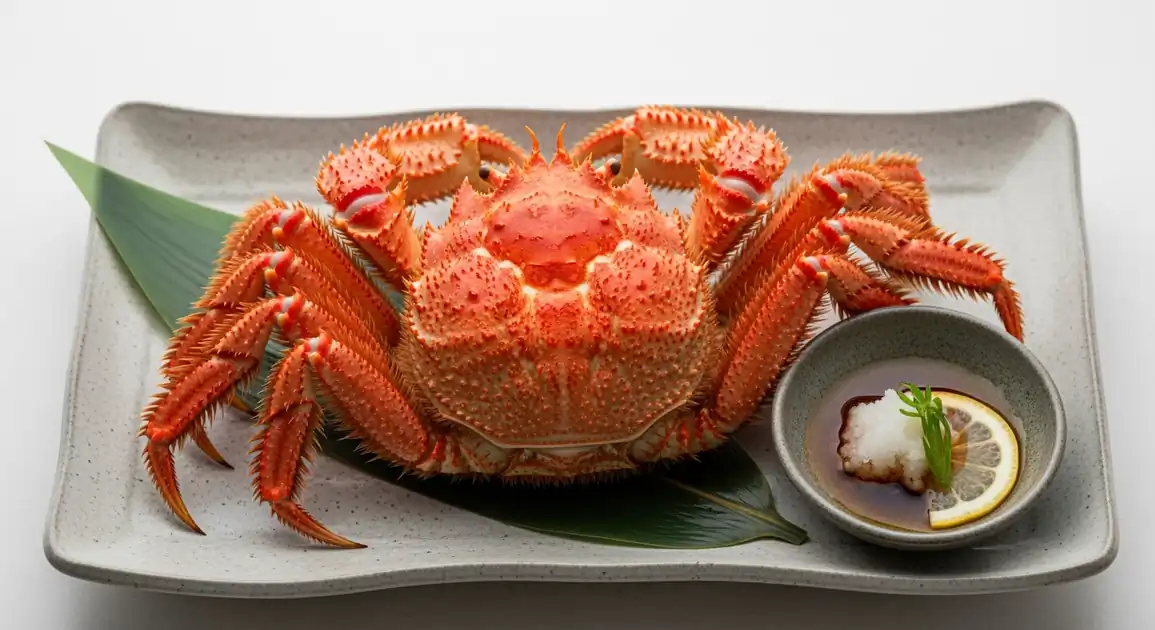Kegani (Horsehair Crab)
毛蟹 (Kegani)

Description
Kegani (Horsehair Crab) is primarily associated with Hokkaido, Japan's northernmost island, where it thrives in the cold waters. While available in high-end restaurants and markets across Japan (often frozen outside Hokkaido or peak season), Hokkaido remains the best place to experience it fresh. The peak season is generally winter through spring.
Dietary Information
Serving information
Serving style
Most commonly served whole, boiled or steamed, often chilled. Accompanied by simple condiments like ponzu or vinegar. Eaten using crab tools.
Quick facts
Markets: Early morning to mid-afternoon. Restaurants: Lunch (11 AM - 3 PM), Dinner (5 PM - 10 PM). Depachika: Store hours (approx. 10 AM - 8 PM).
Safety Tips
What to Look For
-
Bright reddish-orange color (if boiled/steamed).
Indicates proper cooking. Dull or brownish color might suggest staleness or improper cooking.
-
Firm shell and feels heavy for its size.
Suggests the crab is full of meat and miso.
-
Fresh, clean sea smell.
Absence of ammonia or any unpleasant 'off' odors is crucial.
-
Reputable vendor/restaurant.
Choose established markets, specialty crab restaurants, or high-end retailers known for quality seafood.
-
Lively movement (if buying live).
Ensures the crab is healthy and fresh.
-
Proper temperature: Served appropriately hot (if freshly cooked) or well-chilled (if pre-boiled).
Avoid lukewarm crab, which could indicate temperature abuse.
What to avoid
-
Strong ammonia or foul smell.
A definitive sign of spoilage.
-
Dull, discolored, or excessively slimy shell/body.
Indicates lack of freshness.
-
Cracked or significantly damaged shell (unless damage just occurred).
Can sometimes indicate poor handling or older stock.
-
Lightweight crab for its size.
May indicate less meat or miso inside.
-
Vendors with poor hygiene or improper storage (e.g., cooked crab not chilled).
Increases risk of contamination and spoilage.
Price information
Price range
Budget tips
- Market prices are generally lower than restaurant prices, especially if buying whole crab.
- Prices fluctuate significantly based on season, size, and catch abundance.
- Frozen Kegani is usually cheaper than fresh.
Value indicators
- Freshness (lively if live, bright color if cooked).
- Size and weight (heavier is better).
- Origin (Hokkaido, especially Okhotsk sea, is highly regarded).
- Abundance and quality of 'kani miso'.
Where to Find This Dish
Hokkaido Seafood Markets
Places like Nijo Market (Sapporo), Hakodate Morning Market, Otaru's Sankaku Market are famous.
Regional fish markets
Morning (markets), Lunch, Dinner
Crab Specialty Restaurants
Found in major cities across Japan, but most concentrated and authentic in Hokkaido.
Famous chain restaurants (Kani Honke), Local specialty restaurants
Lunch, Dinner
Department Store Food Halls ('Depachika')
Offer high-quality, often beautifully packaged, boiled Kegani for takeaway.
Major department stores (Mitsukoshi, Takashimaya, Daimaru)
Daytime
Vendor Tips
- Confirm the price per crab or per 100g before purchasing, especially at markets.
- Ask about the origin and seasonality for the freshest options.
- At markets, many vendors can boil the crab for you on the spot.
How to Order
Regional Variations
-
Whole Boiled/Steamed Kegani
(姿盛り (Sugata-mori) / 茹で毛蟹 (Yude Kegani))
The classic presentation: a whole crab boiled or steamed, served chilled or warm.
-
Grilled Kegani
(焼き毛蟹 (Yaki Kegani))
Parts of the crab, often legs or the shell with miso, are grilled, imparting a smoky flavor.
-
Kegani Hot Pot
(毛蟹鍋 (Kegani Nabe))
Kegani pieces cooked in a communal pot with broth, vegetables, and tofu.
-
Kegani Rice Porridge
(毛蟹雑炊 (Kegani Zosui))
Rice cooked in the leftover flavorful broth from a Kegani hot pot, often with added crab meat and egg.
-
Kani Miso Kourayaki
(蟹味噌甲羅焼き (Kani Miso Kourayaki))
The crab's 'miso' mixed with other ingredients (like sake, egg yolk) and grilled directly in the top shell (koura).
-
Kegani Sushi/Sashimi
(毛蟹寿司/刺身)
Less common due to its delicate nature, but involves using fresh Kegani meat as a sushi topping or thinly sliced sashimi (requires extreme freshness).
Cultural context
History
Harvested from the frigid waters surrounding Hokkaido and the North Pacific, Kegani has been a vital part of the region's fishing industry for generations. Initially a local specialty, advancements in transportation and refrigeration allowed its popularity to spread across Japan, where it is now revered as a premium seasonal ingredient. It embodies the rich seafood culture of Hokkaido and is often associated with winter feasts and special occasions.
Local significance
A symbol of Hokkaido's rich seafood bounty and a luxurious delicacy.
Eating customs
- Eating crab can be a communal and slightly messy affair; tools are essential.
- Savoring the 'kani miso' is a key part of the experience for aficionados.